NIL
Kentucky's Mark Pope sends blunt $200M NIL message to rest of NCAA
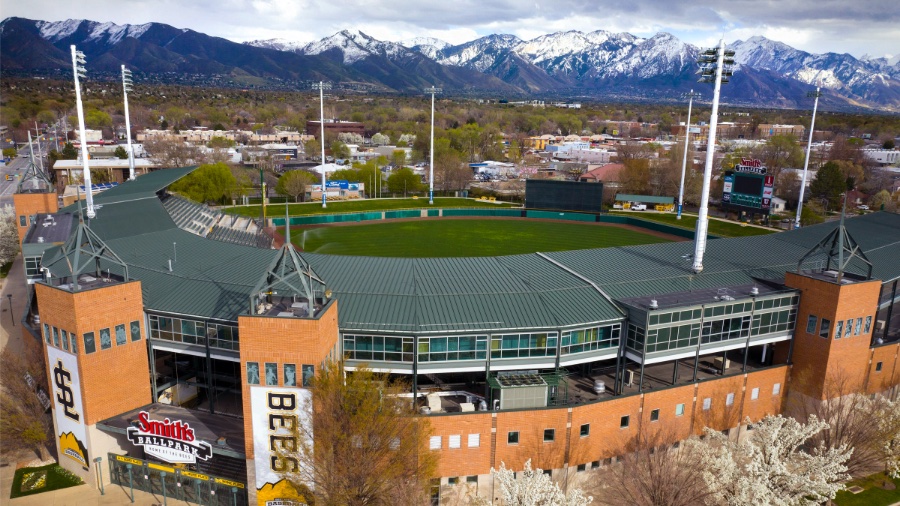

If Kentucky basketball is playing a money game, head coach Mark Pope just went all-in.
With a smirk and a mic-drop moment, Pope claimed the Wildcats are operating on a nearly $200 million roster. Yes, you read that right — $200 million.
Advertisement
“It’s close to $200 million,” Pope said during a recent press conference, flashing a grin. “We would like to win at everything, guys. Like, we really would.”
Whether hyperbole or not, the message was loud and clear: Kentucky is embracing the NIL era with open arms — and deep pockets.
Early projections estimate that the Wildcats’ 2025-26 roster could carry a combined NIL value north of $20 million. That figure alone would place Kentucky among the most lucrative programs in the country. While exact numbers remain speculative, Pope’s public stance adds weight to whispers that Big Blue Nation isn’t just aiming to compete — it’s aiming to lead.
“We want to have the highest NIL. We want to have the best players. We want to win the most games,” Pope emphasized. “This is the flagship program in the country.”

Feb 22, 2025; Tuscaloosa, Alabama, USA; Kentucky Wildcats head coach Mark Pope directs his team against the Alabama Crimson Tide during the first half at Coleman Coliseum. Mandatory Credit: Will McLelland-Imagn Images Will McLelland-Imagn Images
That’s more than talk. Pope, in his second year at the helm, is building a team that reflects that ambition — stacked with high-profile recruits and seasoned transfers drawn by both Kentucky’s legacy and its financial opportunities.
Advertisement
With NIL reshaping the landscape of college sports, Kentucky appears poised to be a model for what elite programs can become: well-funded, player-focused, and unapologetically competitive.
“Our job is to go be the best at everything,” Pope said. “So we’re not shying away from that. Like, it’s important to us.”
As college hoops continues to adapt to a business-first model, Pope’s comments are more than a punchline — they’re a warning shot. Kentucky isn’t just playing the game; it’s rewriting the rules.
Related: Kentucky recruit makes unique decision with bold NIL power move
Related: Kentucky’s bold NIL model has incredible link to HBCU coach
NIL
Oregon vs. Texas Tech set for Orange Bowl: Preview and odds for CFP quarterfinal
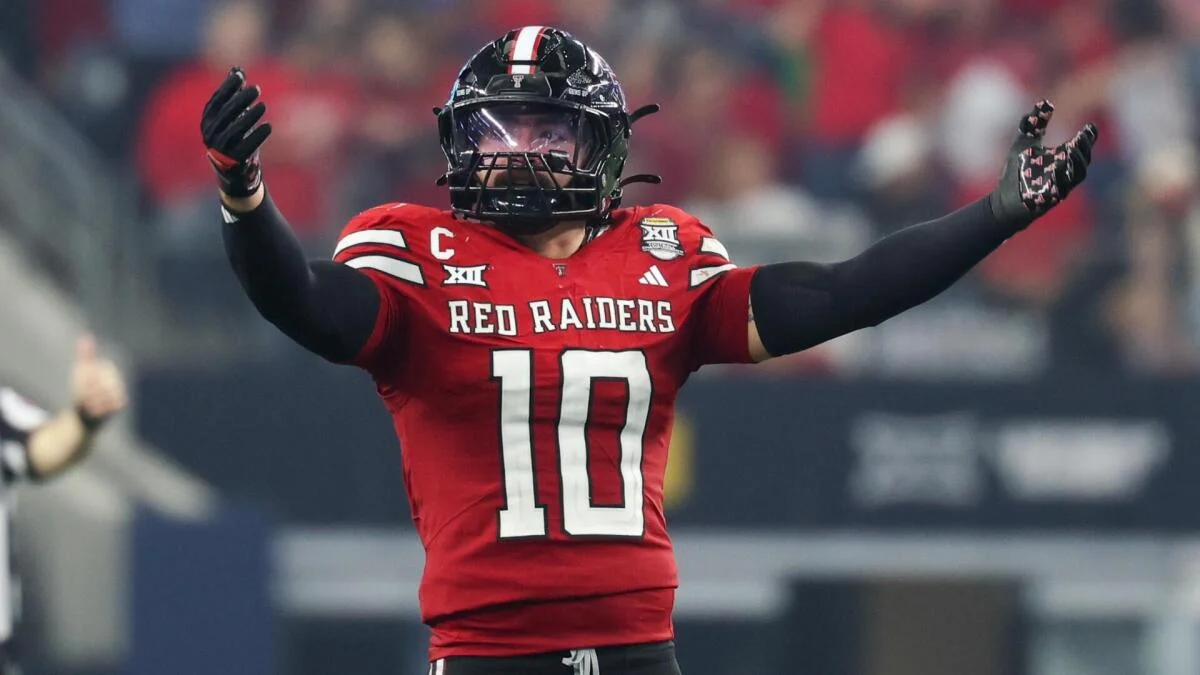
The quarterfinals of the College Football Playoff are upon us, which means the four top seeds will finally get their postseason campaigns underway after a lengthy break following conference championship weekend.
No. 4 Texas Tech waited the longest to officially learn its quarterfinal opponent. But given that No. 5 Oregon entered the first round as a three-touchdown favorite over No. 12 James Madison, the Red Raiders likely got a head start preparing for the Ducks. Despite a spirited effort from the Dukes, Oregon overwhelmed the Sun Belt champions to set up the expected Orange Bowl showdown with Texas Tech — a matchup that could be one of the best games of the entire Playoff.
There’s a fitting symmetry to the pairing. Oregon, once college football’s “new money” program, will face the NIL era’s fastest riser in Texas Tech. The Ducks have established themselves as a consistent national contender over the past two decades, while the Red Raiders poured major resources into their program and surged to the top of the Big 12 this season as a result.
In many ways, Oregon represents a blueprint for how a program like Texas Tech can build sustained excellence. On New Year’s Day in Miami, the Red Raiders will get a chance to show they’ve already closed that gap.
For two programs long defined by high-powered offenses, the defining trait of this season has been dominant defense. Both teams have been excellent offensively — they’re both top 10 nationally in scoring — but their defenses have been the engines of their success. As a result, both offenses will face a significant challenge trying to move the ball consistently in this matchup.

What to know about Texas Tech
The Red Raiders earned the No. 4 seed by riding one of the nation’s best defenses to a dominant season in the Big 12. Aside from a midseason stumble at Arizona State, Texas Tech bullied its way through the conference, including a pair of blowout wins over BYU that cemented a top-four finish in the CFP rankings and secured a first-round bye.
Texas Tech’s defense ranks among the elite nationally, finishing third in scoring defense at 10.9 points allowed per game — trailing only top seeds Indiana and Ohio State. All four of the Red Raiders’ AP All-America selections came on the defensive side of the ball, including first-team honors for linebacker Jacob Rodriguez and EDGE David Bailey.
That star-studded unit will be tasked with slowing an Oregon offense that found its rhythm in the second half of the season and finished ninth nationally in scoring at 38.2 points per game. When the Ducks have the ball, it will be a true strength-on-strength battle. Oregon ranked 14th in rushing offense at 218.4 yards per game, while Texas Tech finished No. 1 nationally in rushing defense, allowing just 68.5 yards per game.
Oregon faced two other top-10 defenses in 2025 and failed to crack 21 points against either — scoring 18 in a win over Iowa and 20 in a loss to Indiana. The Iowa game was played in a downpour, but Indiana held the Ducks to 81 rushing yards on 30 carries. Expect Texas Tech to study that film closely in hopes of replicating what the Hoosiers did up front with their own ultra-talented front seven.
The biggest question for Texas Tech is whether its No. 2 scoring offense can hold up against Oregon’s stout defense. The Red Raiders overwhelmed the Big 12, but in their biggest games — against Utah and BYU twice — the defense led the way. Oregon represents another step up in competition, and Behren Morton, Cameron Dickey and the rest of the offense will need to bring their A-game.

What to know about Oregon
The Ducks did what was expected in a convincing first-round win at home, overpowering James Madison to set up a heavyweight clash in the Orange Bowl.
The challenge for Oregon will be creating space for its playmakers against a hard-hitting Texas Tech defense. Against James Madison, the Ducks enjoyed a clear speed advantage and exploited it throughout the game. The margins will be far tighter against the Red Raiders.
Oregon typically sets up the pass with the run, but that approach may be flipped against Texas Tech. Quarterback Dante Moore could be asked to shoulder more of the load early, using the passing game to loosen the Red Raiders’ front and open opportunities on the ground.
Saturday night’s game against James Madison saw Oregon get almost anything it wanted offensively. That will not be the case on Jan. 1, but Moore looked sharp throwing the ball. His confidence and willingness to push it downfield will be critical if the Ducks’ offense is going to have success against Texas Tech.
Defensively, the question is whether Oregon can create negative plays to knock Texas Tech off schedule. The Red Raiders would prefer to lean on the run game and avoid putting too much on quarterback Behren Morton. Despite a strong overall defensive season, Oregon ranked near the bottom nationally in havoc metrics, finishing with 57 tackles for loss (113th in FBS) and 23 sacks (81st).
Texas Tech’s offense stalled early at times against Utah and BYU, largely due to backfield pressure. While both defenses eventually wore down after spending extended time on the field, the blueprint for slowing the Red Raiders is clear: generate pressure and speed up Morton’s decision-making.
Oregon has been steady defensively all season, but it may need to be more creative in manufacturing the disruption necessary to give Texas Tech problems.
Odds below via FanDuel Sportsbook.
Orange Bowl odds, prediction
I expect a highly competitive game in Miami between the Red Raiders and Ducks as I think there are a lot of similarities between these two teams. Both defenses are excellent and when at their best, the offenses can put up points in bunches. To me this game comes down to which offense can create more explosive plays in a variety of ways, because both defenses are so talented and so good at adapting in-game. I give the Ducks the edge in that department thanks to Moore and see him leading Oregon to a bit of quarterfinal revenge after last year’s dud in the Rose Bowl. PICK: Oregon -1.5
NIL
After Signing Extension To Stay At Arizona State, Kenny Dillingham Sounds Off
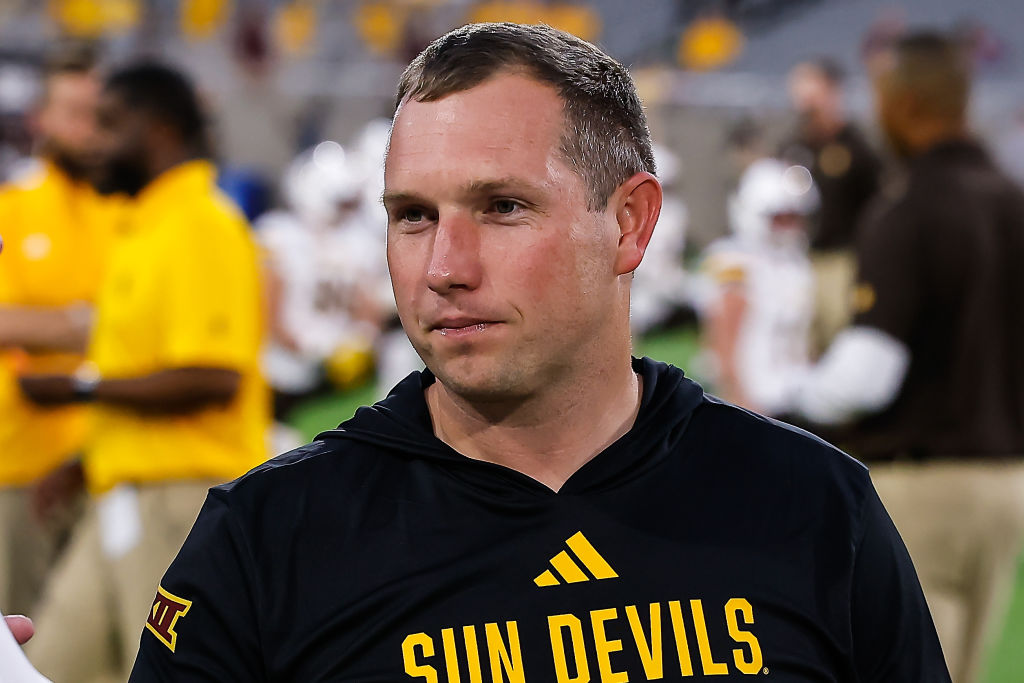
If Sun Devil fans want to stay competitive in the Big 12, they better pony up the big bucks.
Arizona State Sun Devils head coach Kenny Dillingham has enjoyed quite a successful tenure so far in Tempe.
After his first year in which his squad put up a dismal 3-9 record, Dillingham went to work and completely flipped the fortunes of the ASU football program, posting a 19-7 record over the last two seasons, including a Big 12 championship and a College Football Playoff berth.
For his efforts, Dillingham recently received a massive extension and larger salary pool for his assistants, fending off the circling Michigan Wolverines in the process.
Though I’m sure Dillingham is happy to be staying in the Valley of the Sun and is thrilled with his new paycheck, the 35-year-old head coach was recently chatting up the local media and stumping for a different kind of payday.
It’s easy to look at Dillingham saying these things and see him as greedy or ungrateful, but he’s spot on, and the sad reality is that this is the new norm for the sport of college football.
The name of the game is roster building and retention, and if you want to compete in the Power 4 leagues and consistently make the College Football Playoff, you had better pony up some serious dough.
A sum like $20 million might seem like a ridiculous demand, but that’s a pretty reasonable number in today’s NIL arms race.
The Texas Techs of the world are going to do whatever it takes to win, and if Dillingham wants the Big 12 to run through Tempe and not Lubbock, then he is doing the right thing by lobbying for some of those billionaires living in Arizona to stroke a check.
It’s disgusting and gross and goes against everything that college football used to be about, but this junk isn’t going anywhere, so you either adapt or die.
Dillingham is adapting, now we will see if the big money players will follow his lead.
Because if they don’t, things could get very dark very soon for the Sun Devils.
NIL
2025-26 College Football Playoff: What’s next for each eliminated playoff team?
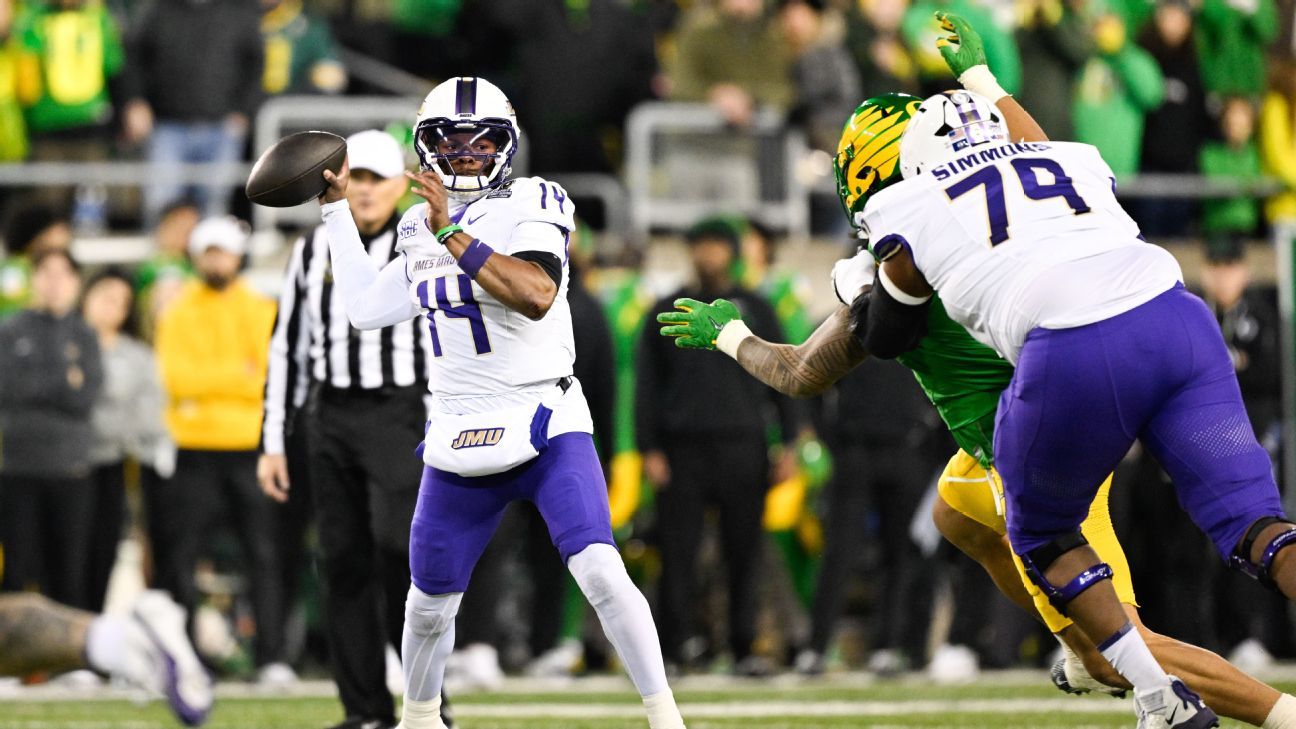
And then there were eight.
The 2025-26 College Football Playoff is here, and Saturday evening has given us our fourth eliminated team of the playoff in the James Madison Dukes. So what happens now?
We’ll tackle big questions, recruiting outlooks, portal and offseason priorities and even offer predictions for next season for every eliminated squad.
Jump to:
James Madison | Tulane
Texas A&M | Oklahoma

![]()
2025 record: 12-2
Biggest question moving forward: Can JMU make it three-for-three on coaching hires? Curt Cignetti reached the top of the mountain in the FCS and led JMU to a stellar start at the FBS level. When he left for Indiana, Bob Chesney arrived and delivered equally impressive results, getting the Dukes into the College Football Playoff. Now, Chesney is off to UCLA, and James Madison turns to Billy Napier, a coach with a history of success in the Sun Belt but who is coming off a disastrous turn at Florida. JMU’s goal has always been to measure itself against its peers rather than the upper echelon of college football, but 2025 offered a taste of the good life, and it’s now on Napier to continue to build toward that again in 2026 and beyond. The job of winning consistently at the Group of Five level has never been harder, and JMU’s aspirations have never been higher. — David Hale
Recruiting outlook: The Dukes emerged as one of the Sun Belt’s premier programs under Cignetti and Chesney, and there’s no reason to think they’ll fall off moving forward with Napier in charge. James Madison’s latest class is led by three-star cornerback Kamden Jennings, an undersized but explosive defensive back from Alpharetta, Georgia. He’s joined in the program’s secondary class by cornerback Kyle Bynes and safety D’Kwan Thomas, while defensive tackle Cory Simon arrives as a high-upside prospect. Within a deep wide receiver class, three-star Ben Whitver marks an intriguing addition with Power 4 measurables at 6-foot-2, 190 pounds. — Eli Lederman
Biggest portal priority: When Cignetti left to take over at Indiana after the 2023 season, he and his coaches took 13 players with them to Bloomington, many of whom became program leaders and All-Big Ten performers. How many Dukes will choose to move across the country to UCLA with Chesney? Alonza Barnett III, Wayne Knight, Sahir West and the rest of their top returning players have big decisions to make now, and Napier will do what he can to hold this roster together before shifting his focus to reloading in the portal. The combination of graduating seniors and potential portal defections in January likely means JMU’s starting lineup will feature lots of new faces to open the 2026 season, but Chesney’s tenure proved this program can quickly recover from a coaching transition and get right back to Sun Belt contender status. — Max Olson
Under-the-radar offseason priority: James Madison has played 40 games in three years at the FBS level, so there’s a certain level of expectation that the dominance will continue. Expectations can be dangerous, however. On its third coach in five years, maintaining high standards can be tough. With so much success, bigger schools are waiting to pick off the best talent, as is life in the Group of Five these days. But even on top of all that, so much continuous winning can breed a level of apathy when the locker room is also changing rapidly — with new players arriving and expecting the same results without fully appreciating what went into achieving that historic success. Just in the Sun Belt, App State, Coastal Carolina and Napier’s former team, Louisiana, have all had their stretches at the top, but tumbled back to earth. Reenergizing JMU after reaching what feels like a new mountaintop in 2025 will be a critical job for Napier in Year 1 on the job. — Hale
2026 prediction: JMU’s 2026 schedule looks inviting. The Dukes get a Liberty team that has been down as of late, a UConn team in the first year with a new coach and a Virginia Tech team that will just be getting its sea legs under James Franklin. Run the table out of conference, and this year showed the door is wide open for a playoff berth. The Sun Belt isn’t likely to struggle in 2026 quite as much as it did in 2025, but JMU still seems to be the clear front-runner. To aim for a second straight playoff bid is reasonable, even if realistic expectations should focus on winning the Sun Belt again and hoping the other dominoes fall into place from there. — Hale
2025 record: 11-3
Biggest question moving forward: Tulane has handled challenging coaching transitions before, going from longtime boss Willie Fritz to Jon Sumrall without any significant backslide. But Sumrall leaves a significant void as he leaves to become the head coach at Florida, and though promoting Will Hall as his successor creates some immediate stability, Hall will have to reprove himself as a program leader after a very rough end to his tenure at Southern Miss. The expectations have changed at Tulane, which is 33-13 since the start of the 2022 season. The program is set up not to revert to its pre-Fritz struggles. But the American Conference will remain a challenge, especially with significant investments at programs such as South Florida and Memphis. Similar to a lot of Group of 5 CFP teams, Tulane will lose a lot, both to graduation and the portal, and Hall and his staff will need to identify a new quarterback, replenish the offensive line and replace key defenders such as Santana Hopper and Sam Howard. — Adam Rittenberg
Recruiting outlook: The Green Wave’s 2026 class faded late, with five decommitments after Nov. 18 amid coach Jon Sumrall’s departure for Florida, headlined by the exit of four-star wide receiver Trez Davis. Still, Tulane is set to add some intriguing talent in 2026. In three-star signee A.J. Westfield, the program has its highest-ranked defensive tackle since the Green Wave landed defensive tackle Alfred Thomas and Jeffery Johnson in the 2018 class. Offensive tackle Aiden Martin and guards Tylan George and Andre Amos Jr. will provide reinforcement on the other side of the line of scrimmage. And in the skill positions, first-year coach Will Hall will have three exciting newcomers to work with — wide receivers Keyshaun Coleman and Gary Hadley Jr. and tight end Colby Simpson. — Eli Lederman
Biggest portal priority: Like any Group of 5 program going through a head coaching transition, Tulane will likely have a lot of work to do when the transfer portal opens Jan. 2. We’ll see how much roster attrition newly promoted coach Will Hall and his staff endure now that the season is over and players have Power 4 opportunities to consider. The Green Wave lost a dozen transfers to P4 programs last offseason, and all-conference defensive lineman Hopper has already announced he plans to enter the portal next month. Players who have a chance to go to Florida will have a tough time turning down those lucrative offers. There are also a bunch of freshmen on this roster who played big roles in 2025, including Jamauri McClure, Javin Gordon, Reese Baker, E’zaiah Shine and Zycarl Lewis Jr. If the new staff retains some players over these next few weeks, that’d be a good place to start. — Max Olson
Under-the-radar offseason priority: The defensive line will be an area to watch, with Hopper already heading out and others possibly to follow, but Tulane also must fortify its depth on the offensive line. First-team all-conference guard Shadre Hurst would be a massive retention, but if he moves on, along with seniors Derrick Graham, Jack Hollifield and Jordan Hall, Tulane will have to devote a lot of energy toward building around its lone returning starter, right tackle Reese Baker. Hall and Hollifield were valuable additions in last year’s portal, and Tulane should be an attractive destination for transfers with the offensive system likely not changing too much under Will Hall. — Rittenberg
2026 prediction: The Hall hire will be closely scrutinized, as Tulane prioritized continuity over candidates with more appealing credentials. Hall knows the place well after two stints as a Green Wave assistant, and he had success as a head coach earlier in his career at West Alabama and West Georgia, before the struggles at Southern Miss (14-30). Tulane’s 2026 schedule features nonleague road trips to Duke (former Tulane QB Darian Mensah is back to lead the Blue Devils) and Kansas State, as well as conference games at Army and South Florida. Given the turnover with the coaching staff and roster, Tulane is probably a seven- or eight-win team. — Rittenberg
2025 record: 11-2
Biggest question moving forward: Mike Elko loses both coordinators, with OC Collin Klein heading to his alma mater to be the head coach at Kansas State and DC Jay Bateman joining new Kentucky coach Will Stein to run the defense. Elko has opted for continuity in both roles, promoting co-OC and wide receivers coach Holmon Wiggins to take over playcalling duties and elevating Lyle Hemphill, Elko’s associate head coach for defense, to DC. Hemphill has worked with Elko since his days at Hofstra in 2006, and also served as his defensive coordinator at Duke, rejoining his staff earlier this year. Wiggins, however, is more of an unknown since this will be his first role as the coordinator. But his impact on A&M’s offense over the past two years is evident in the receivers he has identified and developed, from the additions of Mario Craver and KC Concepcion to the development of Ashton Bethel-Roman. — Dave Wilson
Recruiting outlook: The Aggies stocked up on elite defenders for another cycle on their way to landing the nation’s No. 6 class. The headliner is five-star athlete Brandon Arrington (No. 18 overall), a star sprinter from San Diego who is expected to play cornerback and could contribute on special teams from the jump. Arrington will be joined by another pair of top 100 cornerbacks in Victor Singleton (No. 56) and Camren Hamiel (No. 85) in a Texas A&M class filled with nine ESPN 300 defenders. The Aggies beat in-state rivals to an intriguing running back prospect over the summer in four-star rusher K.J. Edwards (No. 50). And Mike Elko is already rolling in the 2027 cycle, too, entering the offseason already holding onto pledges from seven members of the ESPN Junior 300, led by No. 3 dual-threat quarterback Jayce Johnson and a trio of top 70 defensive backs between JayQuan Snell, Kamarui Dorsey and Raylaun Henry. — Lederman
Biggest portal priority: Texas A&M has done an excellent job of evaluating talent in portal recruiting under Elko and finding players who fit. Last year, the glaring need was wide receiver, and the duo of Concepcion and Craver far exceeded expectations. This time around, the focus probably starts up front. Expect the Aggies to be in the mix for the top offensive tackles available as they try to find an SEC-caliber big man to take over for four-year starter Trey Zuhn III and two-year starter Dametrious Crownover. They’ll likely look into blue-chip defensive linemen as well to keep building on what this D-line achieved in 2025, and a linebacker could be needed as well if Taurean York goes pro. Craver has already re-signed to return in 2026, but there will be many more difference-makers available at wide receiver when the portal opens on Jan. 2. — Olson
Under-the-radar offseason priority: The Aggies were just 15 of 24 on field goal attempts this season, including getting a 22-yarder blocked by Jared Zirkel, who began the year as a kickoff specialist, against Miami, in a game where every point mattered. Randy Bond, the Aggies’ starting kicker, was 12-of-19 this season. The Aggies signed kicker Asher Murray out of Shreveport, Louisiana, who was 18-of-22, with a career long of 56 yards in his high school career. Elko said during his signing day news conference that Murray has a chance to be a weapon for the Aggies. — Wilson
2026 prediction: Quarterback Marcel Reed returns, but after a season in which he showcased his development, he also struggled down the stretch against South Carolina (until he played brilliantly in the second half), Texas and Miami. He’ll need to find another gear if the Aggies hope to repeat their historic 2025 season. Another 11-1 regular season looks difficult with a regular season that ends with a five-game slate that includes trips to Alabama, South Carolina and Oklahoma and home games against Tennessee and Texas. A 9-3 season looks to be challenging but also a success in the SEC’s new nine-game lineup. — Wilson
2025 record: 10-3
Biggest question moving forward: Oklahoma made important investments in its offense after the 2024 season, adding quarterback John Mateer and coordinator Ben Arbuckle from Washington State, wide receiver Isaiah Sategna III from Arkansas and other reinforcements. The Sooners now need to see the unit take a sustained step forward, or advancing in the CFP will become increasingly difficult. The offense was extremely limited during OU’s stretch run, even in wins against Alabama, Missouri and LSU. If not for superb defense and special teams, OU would have missed the CFP for a fifth consecutive season. Arbuckle will get another chance to truly upgrade the unit, and if Mateer returns rather than entering the NFL draft, the Sooners will have some beneficial continuity. OU’s offense has been hit hard by injuries in recent years, and getting Mateer healthy along with the running back room gives the unit a chance for a true breakthrough in 2026. The Sooners need to get their run game out of the 100s and ideally into the top 35 next season. — Rittenberg
Recruiting outlook: The Sooners enter the offseason prepared to add ESPN’s 16th-ranked recruiting class in 2026. The gem of coach Brent Venables’ latest class is five-star defensive end Jake Kreul (No. 25 overall), a technically-advanced edge rusher from Florida and Oklahoma’s fifth five-star signee over the past four cycles. The Sooners secured a pair of intriguing offensive additions just before the early signing period between No. 5 running back Jonathan Hatton Jr. (No. 71) and four-star wide receiver Jayden Petit (No. 178). Bowe Bentley, ESPN’s No. 2 dual-threat passer, was a priority target for Oklahoma offensive coordinator Ben Arbuckle, and he should be viewed as a potential quarterback for the Sooners when he joins the program in January. — Lederman
Biggest portal priority: Assuming Mateer bypasses the NFL draft and returns in 2026, it’ll be interesting to see how general manager Jim Nagy and the Sooners attack this upcoming January portal cycle to surround their QB1 with more premium help on offense. Expect the Sooners to go out and get proven starters at tight end and wide receiver to complement their returning playmakers and help Arbuckle’s offense take the next step in his second year. Linebackers could potentially emerge as a major need for Venables’ defense if Kip Lewis and Kobie McKinzie enter the draft and if Owen Heinecke can’t get an NCAA waiver for an extra year. Sammy Omosigho will need to step up if starters depart at that spot, but he will certainly need more help. — Olson
Under-the-radar offseason priority: Oklahoma should bring back a chunk of its depth chart on offense for 2026, but the Sooners — just like any contending team — could always use more experience on the line. The team will lose second-team All-SEC guard Febechi Nwaiwu and veteran right tackle Derek Simmons, and it needs to invest around returning players such as Michael Fasusi, who started all but three games at left tackle as a freshman. The Sooners also need playmakers for Mateer, as wide receiver Deion Burks and tight end Jaren Kanak move on and Sategna, a fourth-year junior, is a candidate to leave for the NFL draft. — Rittenberg
2026 prediction: Oklahoma was far from dominant — the Sooners won four SEC games by seven points or fewer — but showed it could hold up in a challenging SEC schedule and earn a CFP spot, albeit short-lived. The personnel picture should continue to improve in Norman, and Oklahoma should bring back enough to be in the CFP mix again. There are some significant questions about an offense that stalled out too often, though, and will be challenged early next season with Georgia (road), Texas (neutral) and Michigan (road) all within the first five games. The middle portion of the schedule softens a bit before Oklahoma closes with two CFP teams, Ole Miss and Texas A&M, in Norman and a trip to Missouri. Another 10-win season is possible, but I’ll say 9-3 for Oklahoma and very much on the CFP bubble. — Rittenberg
NIL
The staggering NIL figure that transfer portal QBs are expected to cost
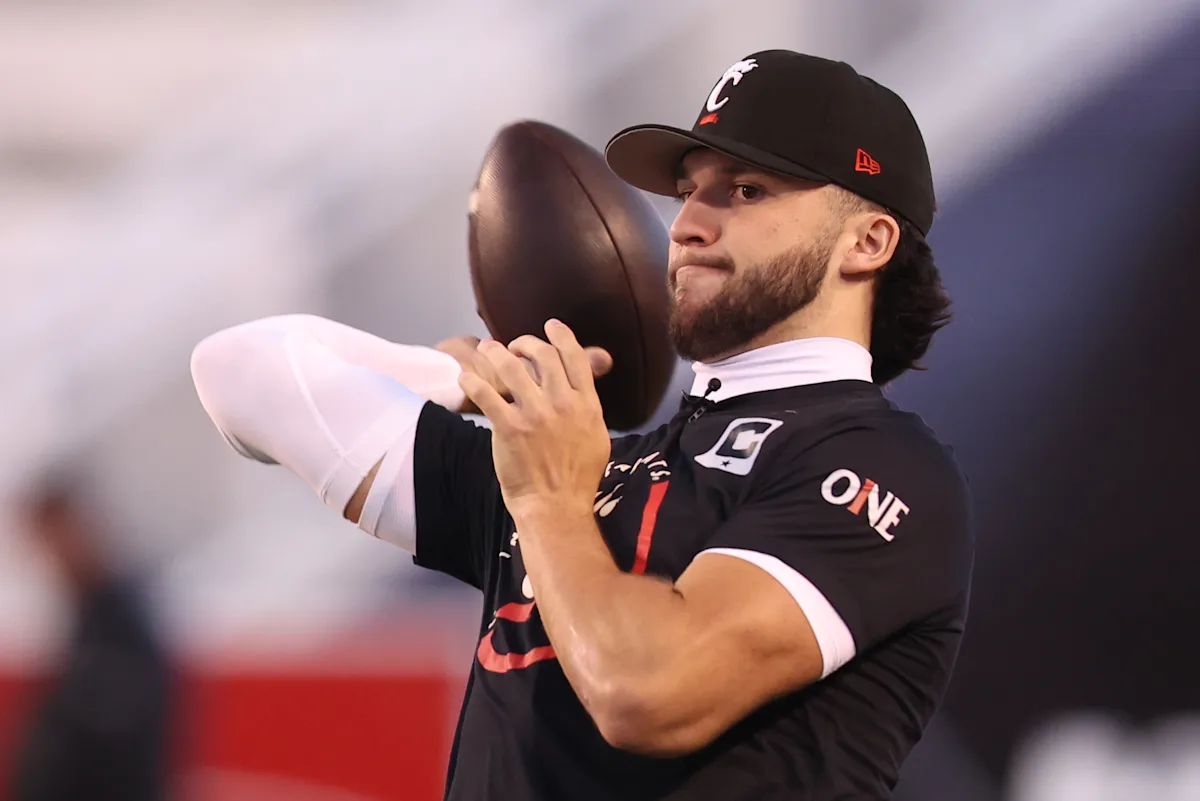
If you thought the NIL transfer market in college football already was out of control, just wait until the upcoming battles next month for the top quarterbacks looking to switch schools.
ESPN college football insider Pete Thamel believes the dollar figures during the January cycle could be as much as $5 million for one season.
Advertisement
“This market looks robust already, guys,” Thamel said Friday on College GameDay ahead of Alabama’s playoff win over Oklahoma. “You’ve got Cincinnati’s Brendan Sorsby at [the top], Nebraska’s Dylan Raiola, TCU’s Josh Hoover went in [this week], you have Arizona State’s Sam Leavitt, Florida’s DJ Lagway.”

Cincinnati Bearcats quarterback Brendan Sorsby (2) warms up before the game against the Utah Utes at Rice-Eccles Stadium. Rob Gray-Imagn Images
“So I made some calls today, guys, and sources told me the tip-top of this quarterback market, financially, could reach $5 million for one season. Look, it’s supply and demand. You have all those guys. Sorsby’s been linked early to Texas Tech. Dylan Raiola, there’s some smoke to Louisville, although maybe a [College Football Playoff] team jumps in late there. There have been early links between Indiana and Hoover, assuming that [Heisman Trophy winner Fernando Mendoza] goes pro.”
Thamel also noted that CFP programs such as Oregon and Miami are likely to be looking for a new quarterback for 2026, as well as LSU, with new coach Lane Kiffin looking to make a splash.
“Look, this is what’s going to drive the market,” Thamel said. “Oregon may lose [draft prospect] Dante Moore. Miami will be in the quarterback market again. So will LSU. So, when you really take a look at what could drive this quarterback market, it’s going to be the most expensive in the history of college football.”
Advertisement
Thamel also pointed out that seven of the past nine Heisman winners landed at those schools through the transfer portal, including Mendoza, who moved from Cal to Indiana for this season.
The main transfer portal window is open from Jan. 2-16.
NIL
Trinidad Chambliss waiver: ESPN reveals Ole Miss’ expected timeline for response from NCAA
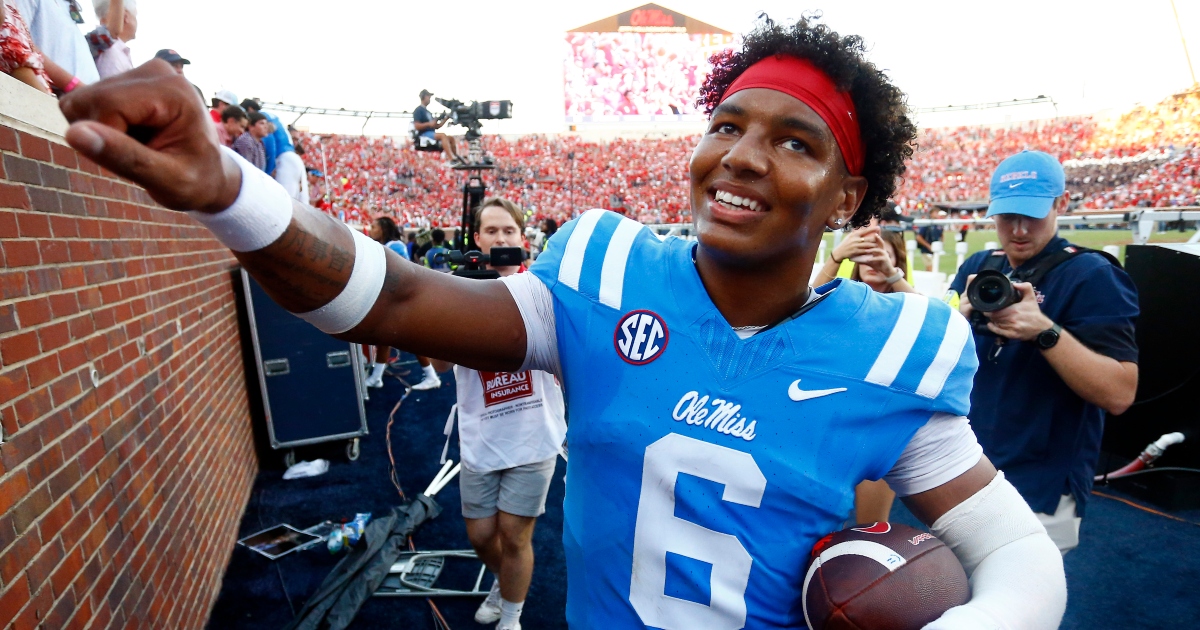
Amid a decorated season at Ole Miss after transferring from Division II Ferris State, Trinidad Chambliss is seeking another year of eligibility. He applied for a waiver, and ESPN’s Katie George shared the timeline for which the Rebels are expecting an answer.
Ole Miss expected about a month-long wait for a response from the NCAA, George said during Saturday’s College Football Playoff game against Tulane. Chambliss told the ESPN broadcast crew, which is calling the game on TNT, he applied for the waiver three weeks ago. As a result, the school is expecting a response to come down soon.
Chambliss spent three years at Ferris State before arriving at Ole Miss this season. However, he only played in two games as a freshman due to multiple health issues, which is why he’s seeking one more season at the FBS level.
“He said that they filed the waiver three weeks ago,” George reported during the first half. “Ole Miss expects it to take a month before they get an answer.
“Back in 2022 when he was at Ferris State, he did not play in a single game due to chronic tonsillitis, heart palpitations and trouble breathing, so he medically redshirted. After the season he had, proving he’s capable of playing at this level, he wants another year to build on his progress.”
After transferring to Ole Miss this year, Chambliss initially served as the backup quarterback behind Austin Simmons. However, after Simmons suffered an injury, Chambliss took the starting job and ran with it as he helped lead the Rebels to their first-ever College Football Playoff appearance.
Across his 12 appearances, Trinidad Chambliss completed 65.5% of his passes for 3,016 yards and 18 touchdowns, to three interceptions. He also added 470 rushing yards and six touchdowns on the ground. In the process, Chambliss also put himself in the Heisman Trophy conversation, finishing eighth in the voting for college football’s most prestigious award.
But as he waits for an answer on his waiver, Chambliss is keeping everything in perspective. During a press conference ahead of the CFP first round, he said he’s preparing for “every possibility” with his future still up in the air.
“I would have to consider, like, what the best situation is for me,” Chambliss said. “What I feel more comfortable with. Who I trust the most and I’m just going to feel for every possibility, really. There’s a lot that goes into that.”
NIL
No. 1 transfer portal player linked to major college football program
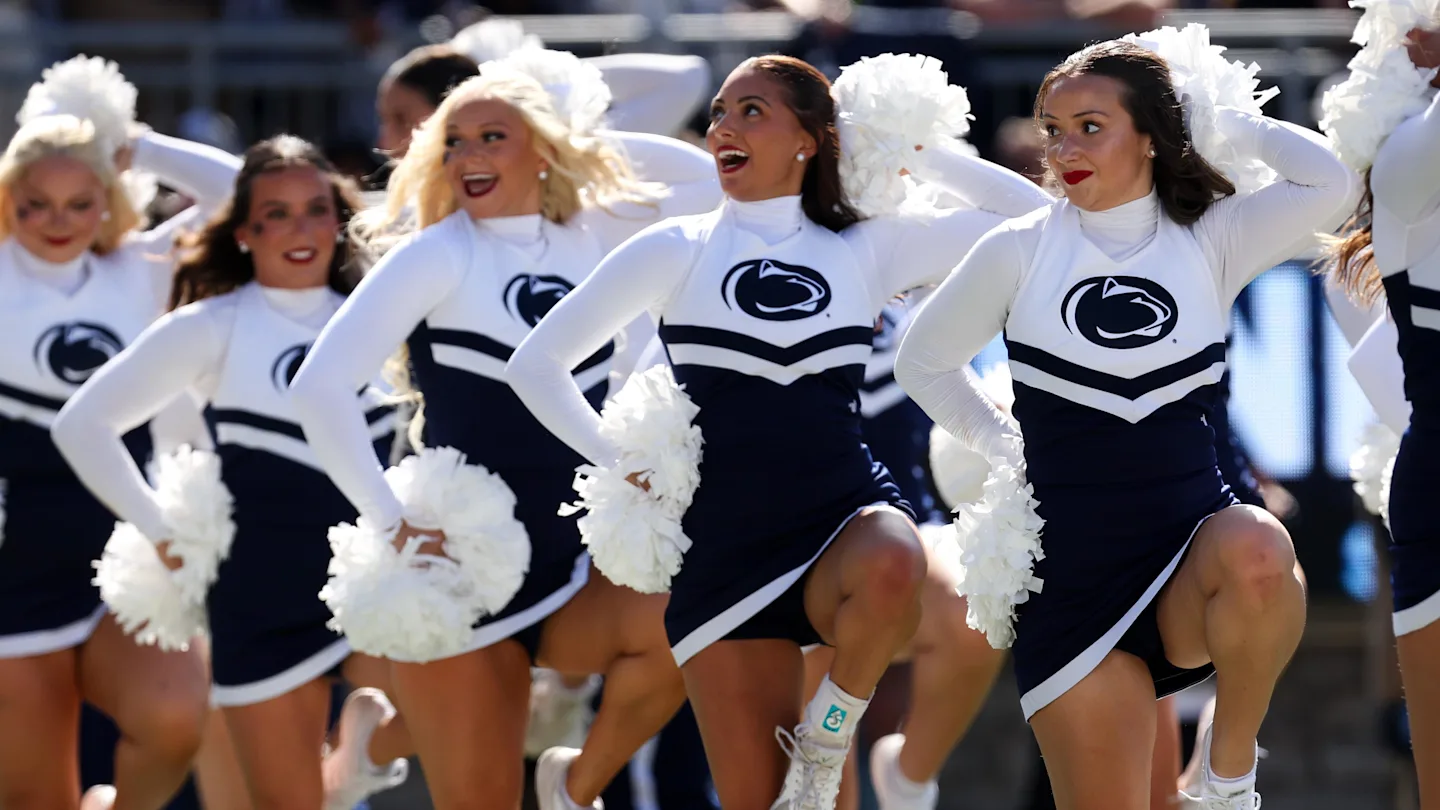
The newly top-ranked overall prospect in the 2025 college football transfer portal has now been linked to a major college football program and a rival of his former team.
Penn State defensive end Chaz Coleman is entering the NCAA transfer portal ahead of the 2026 football season, and reigning national champion Ohio State has emerged as an early school to watch for his forthcoming decision, according to On3 Sports.
Ohio State made a late push to earn the commitment of the in-state edge rusher back when he was a recruit, but he ultimately chose the Nittany Lions, where he got some early, and very promising, exposure.
Now, as that program embarks on the post-James Franklin future, it appears Coleman is looking for an exit, and their Big Ten rival is an early contender to pounce on him.
Early production
A former four-star prospect from Warren, Ohio, the edge rusher was given playing time at Penn State as a true freshman this past season, notching 8 stops with 3 tackles for loss, adding 1 sack, a forced fumble, a pair of fumble recoveries, and a pass defense in that time.
Coleman was considered the No. 25 ranked defensive and the No. 8 prospect from the state of Ohio as a high school player, according to a consensus of the national recruiting services.
Top-ranked transfer
Following news of his intention to transfer, Coleman quickly shot up to the No. 1 position nationally as the best player in the portal, according to the latest 247Sports Composite standings.
“Chaz Coleman has been one of the most dynamic true freshman pass rushers in college football this season,” Rivals scouting director Charles Power said in an assessment of the player.
That early production and continued promise is expected to cost a school considerable money, as Coleman is projected to command a seven-figure package wherever he lands as a transfer, according to the On3 report.
How the college football transfer portal works
College football’s transfer portal officially opens on Jan. 2, but that hasn’t stopped a flurry of players from entering their names for consideration at a new school right now.
The new 15-day transfer portal window from Jan. 2-16 and the elimination of the spring transfer period has condensed the timeline for players and programs to make their moves.
The NCAA Transfer Portal is a private database that includes the names of student-athletes in every sport at the Division I, II, and III levels. The full list of names is not available to the public.
A player can enter their name into the transfer portal through their school’s compliance office.
Once a player gives written notification of their intent to transfer, the office puts the player’s name into the database, and they officially become a transfer.
The compliance office has 48 hours to comply with the player’s request and NCAA rules forbid anyone from refusing that request.
The database includes the player’s name, contact information, info on whether the player was on scholarship, and if he is a graduate student.
Once a player’s name appears in the transfer portal database, other schools are free to contact the player, who can change his mind at any point in the process and withdraw from the transfer portal.
Notably, once a player enters the portal, his school no longer has to honor the athletic scholarship it gave him.
And if that player decides to leave the portal and return to his original school, the school doesn’t have to give him another scholarship.
More college football from SI: Top 25 Rankings | Schedule | Teams
Follow College Football HQ: Bookmark | Rankings | Picks
-

 Motorsports2 weeks ago
Motorsports2 weeks agoSoundGear Named Entitlement Sponsor of Spears CARS Tour Southwest Opener
-

 Motorsports2 weeks ago
Motorsports2 weeks agoDonny Schatz finds new home for 2026, inks full-time deal with CJB Motorsports – InForum
-

 Rec Sports2 weeks ago
Rec Sports2 weeks agoHow Donald Trump became FIFA’s ‘soccer president’ long before World Cup draw
-
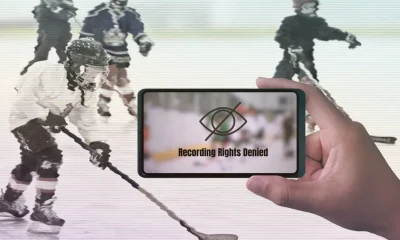
 Rec Sports2 weeks ago
Rec Sports2 weeks agoBlack Bear Revises Recording Policies After Rulebook Language Surfaces via Lever
-
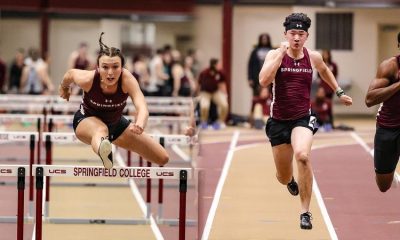
 Sports3 weeks ago
Sports3 weeks agoMen’s and Women’s Track and Field Release 2026 Indoor Schedule with Opener Slated for December 6 at Home
-

 Rec Sports2 weeks ago
Rec Sports2 weeks agoDavid Blitzer, Harris Blitzer Sports & Entertainment
-
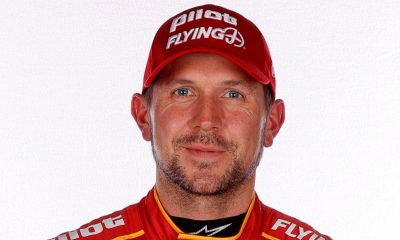
 Motorsports2 weeks ago
Motorsports2 weeks agoJR Motorsports Confirms Death Of NASCAR Veteran Michael Annett At Age 39
-

 Motorsports2 weeks ago
Motorsports2 weeks agoRick Ware Racing switching to Chevrolet for 2026
-
Sports2 weeks ago
Elliot and Thuotte Highlight Men’s Indoor Track and Field Season Opener
-
Sports2 weeks ago
West Fargo volleyball coach Kelsey Titus resigns after four seasons – InForum



































